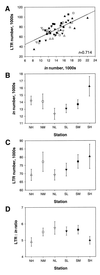Genome evolution of wild barley (Hordeum spontaneum) by BARE-1 retrotransposon dynamics in response to sharp microclimatic divergence
- PMID: 10823912
- PMCID: PMC18673
- DOI: 10.1073/pnas.110587497
Genome evolution of wild barley (Hordeum spontaneum) by BARE-1 retrotransposon dynamics in response to sharp microclimatic divergence
Abstract
The replicative spread of retrotransposons in the genome creates new insertional polymorphisms, increasing retrotransposon numbers and potentially both their share of the genome and genome size. The BARE-1 retrotransposon constitutes a major, dispersed, active component of Hordeum genomes, and BARE-1 number is positively correlated with genome size. We have examined genome size and BARE-1 insertion patterns and number in wild barley, Hordeum spontaneum, in Evolution Canyon, Lower Nahal Oren, Mount Carmel, Israel, along a transect presenting sharply differing microclimates. BARE-1 has been sufficiently active for its insertional pattern to resolve individuals in a way consonant with their ecogeographical distribution in the canyon and to distinguish them from provenances outside the canyon. On both slopes, but especially on the drier south-facing slope, a simultaneous increase in the BARE-1 copy number and a decrease in the relative number lost through recombination, as measured by the abundance of solo long terminal repeats, appear to have driven the BARE-1 share of the genome upward with the height and dryness of the slope. The lower recombinational loss would favor maintenance of more full-length copies, enhancing the ability of the BARE-1 family to contribute to genome size growth. These local data are consistent with regional trends for BARE-1 in H. spontaneum across Israel and therefore may reflect adaptive selection for increasing genome size through retrotransposon activity.
Figures



Comment in
-
Retrotransposon-mediated genome evolution on a local ecological scale.Proc Natl Acad Sci U S A. 2000 Jun 6;97(12):6250-2. doi: 10.1073/pnas.97.12.6250. Proc Natl Acad Sci U S A. 2000. PMID: 10841529 Free PMC article. No abstract available.
Similar articles
-
Adaptive microclimatic structural and expressional dehydrin 1 evolution in wild barley, Hordeum spontaneum, at 'Evolution Canyon', Mount Carmel, Israel.Mol Ecol. 2009 May;18(9):2063-75. doi: 10.1111/j.1365-294X.2009.04140.x. Epub 2009 Mar 26. Mol Ecol. 2009. PMID: 19344351
-
Quantification of the retrotransposon BARE-1 reveals the dynamic nature of the barley genome.Genome. 2006 Apr;49(4):389-96. doi: 10.1139/g05-119. Genome. 2006. PMID: 16699559
-
Structure, functionality, and evolution of the BARE-1 retrotransposon of barley.Genetica. 1999;107(1-3):53-63. Genetica. 1999. PMID: 10952197
-
A movable feast: diverse retrotransposons and their contribution to barley genome dynamics.Cytogenet Genome Res. 2005;110(1-4):598-605. doi: 10.1159/000084993. Cytogenet Genome Res. 2005. PMID: 16093713 Review.
-
LTR retrotransposons and flowering plant genome size: emergence of the increase/decrease model.Cytogenet Genome Res. 2005;110(1-4):91-107. doi: 10.1159/000084941. Cytogenet Genome Res. 2005. PMID: 16093661 Review.
Cited by
-
Cytosine methylation alteration in natural populations of Leymus chinensis induced by multiple abiotic stresses.PLoS One. 2013;8(2):e55772. doi: 10.1371/journal.pone.0055772. Epub 2013 Feb 13. PLoS One. 2013. PMID: 23418457 Free PMC article.
-
Genome size variation in diploid and tetraploid wild wheats.AoB Plants. 2010;2010:plq015. doi: 10.1093/aobpla/plq015. Epub 2010 Sep 30. AoB Plants. 2010. PMID: 22476073 Free PMC article.
-
First evidence of DNA methylation in insect Tribolium castaneum: environmental regulation of DNA methylation within heterochromatin.Epigenetics. 2013 May;8(5):534-41. doi: 10.4161/epi.24507. Epub 2013 Apr 17. Epigenetics. 2013. PMID: 23644818 Free PMC article.
-
Evolutionary Divergence between Toona ciliata and Toona sinensis Assayed with Their Whole Genome Sequences.Genes (Basel). 2022 Oct 5;13(10):1799. doi: 10.3390/genes13101799. Genes (Basel). 2022. PMID: 36292684 Free PMC article.
-
Evolution of satellite DNAs in a radiation of endemic Hawaiian spiders: does concerted evolution of highly repetitive sequences reflect evolutionary history?J Mol Evol. 2004 Nov;59(5):632-41. doi: 10.1007/s00239-004-2655-2. J Mol Evol. 2004. PMID: 15693619
References
Publication types
MeSH terms
Substances
LinkOut - more resources
Full Text Sources

